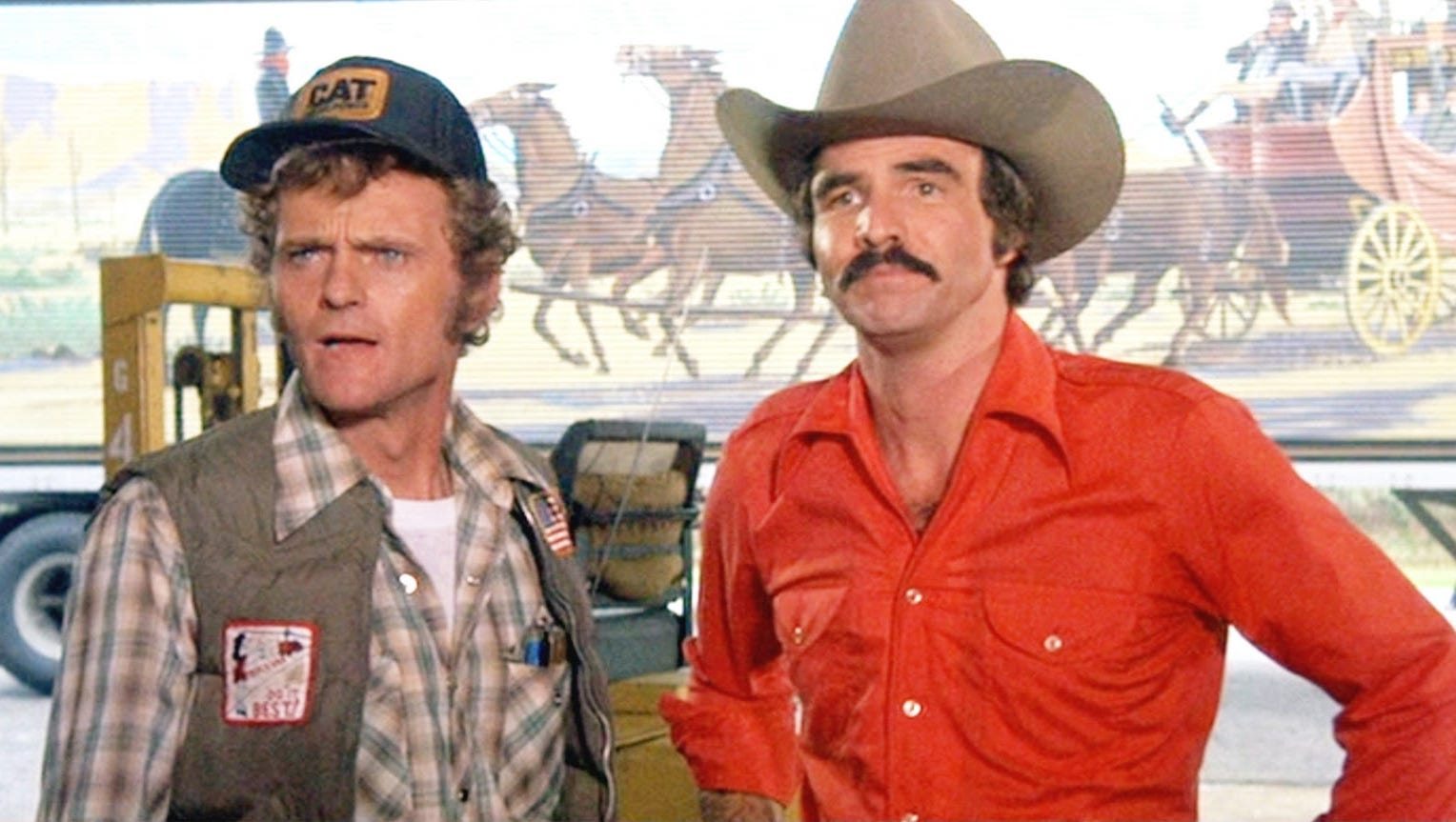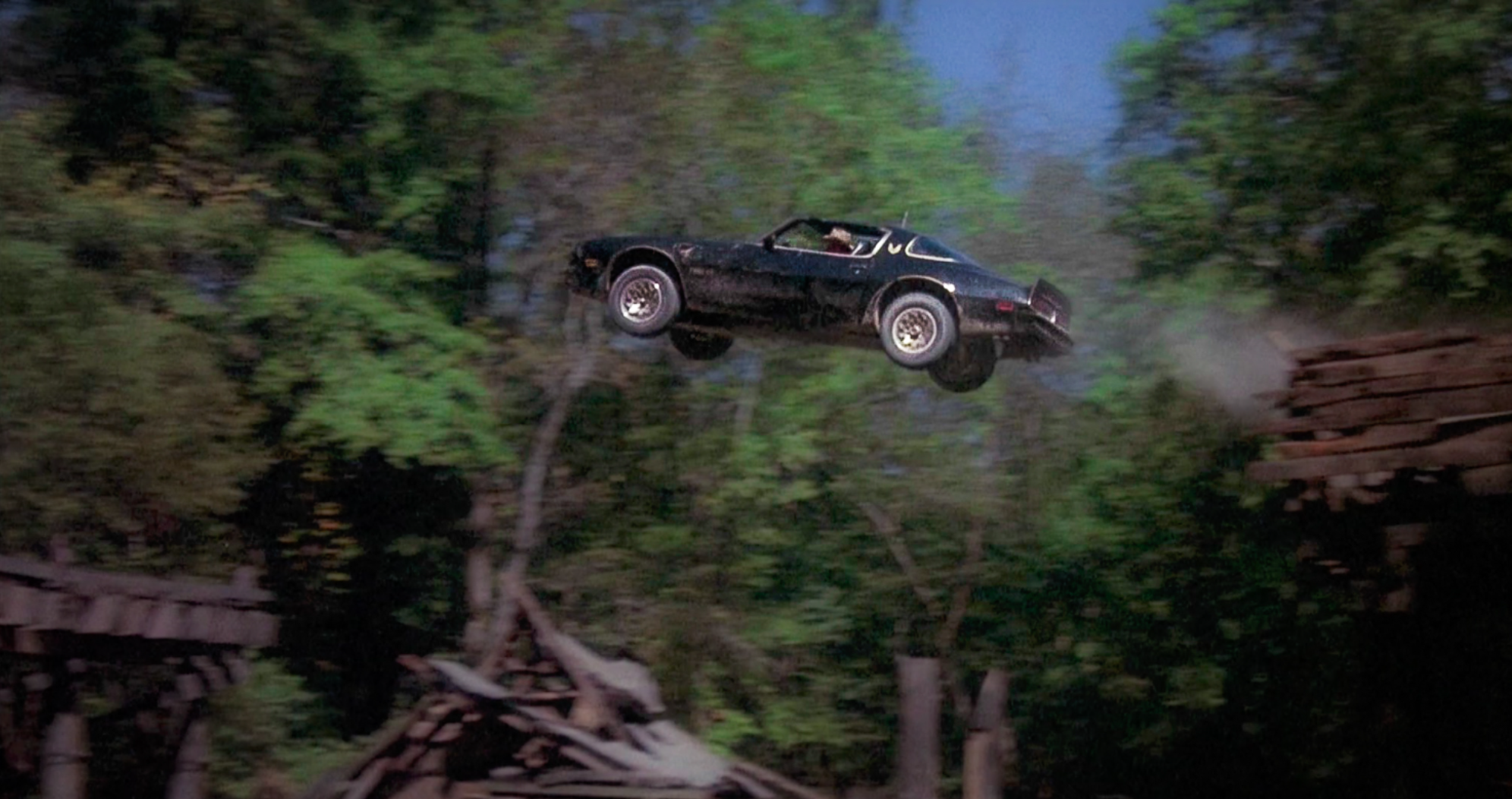A Life in Film is a project where I’m writing about a movie from every year I’ve been alive.
1977: YOU DON’T HAVE TO BE GREAT TO BE AWESOME
SMOKEY AND THE BANDIT (dir. Hal Needham)
Look, I’m not about to claim the Smokey and the Bandit is a great movie. It’s not. But it’s an awesome movie, and that’s nothing to sneeze at.

Admittedly, “awesome” is a pretty subjective characterization, and in this case the case for awesomeness is helped a lot if you happened to be a little kid with access to cable television in the late 1970s and early 80s. And, well, guilty as charged. Bandit’s a very visceral, kinetic movie, all cool cars doing cool things and the triumvirate of Burt Reynolds, Sally Field, and Jerry Reed* radiating charisma; you can see why kids (and the general public) loved it. It’s a sort of golden retriever, all charismatic good cheer with no gravitas and no need for any.
*My only casting beef with this movie is that I don’t think much of what Jackie Gleason does is funny, although that’s OK because he’s the antagonist and he works fine in that role. I know most people don’t agree with me on this, but on the other hand I’m not entirely alone; a friend of mine mentions that he always found Gleason actively terrifying in the role.

It’s a movie made by a stuntman, and it shows, and I think that both explains the movie’s limitations and its strengths. Hal Needham was a longtime stuntman who’d worked his way up to working behind the camera. The story I’ve always heard—and I’ve both never seen it refuted and actively choose to believe it because it’s so endearing—is that Needham consciously wanted to make a movie that was fun an exciting but completely free of violence.* ** So he set to writing Smokey and the Bandit longhand on a set of legal pads, and the whole endeavor got some legs underneath it once Needham’s pal Burt Reynolds, who was one of the biggest stars in the world then, got attached.
*A similar frame of mind, I’m told, went into the creation of Star Trek IV: The Voyage Home, with even happier results. I wish more filmmakers would think this way.
**Someone online pointed out that the film’s not completely violence-free, since Jerry Reed’s Snowman does get beaten up; I think the contradiction here is really just bad wording on my part. I think what Needham was really looking to avoid was gun violence. Still, point taken.
Reynolds reportedly told Needham that this was one of the worst screenplays he’d ever seen, but liked the concept and wanted to make it anyway. The film as shot was largely improvised and rewritten on the fly, with Needham’s stuntman instincts guiding things. And while this could be a recipe for disaster, in this case it worked brilliantly. Former stuntmen might not be great at writing dialog that resounds through the ages (or rising above the not-super-enlightened vibes of the time), but that’s a great background for knowing what’s going to look cool and exciting on a big screen.
(and OK, quick aside: this being the late 70s, yes, there are confederate flags all over the place, and yes, that sucks. I understand if that’s disqualifying for people. A lot of conversation that we take for granted on the matter hadn’t happened yet–although they should have–and it was just a thing in the late 70s to have confederate flags around in a way that seems alien and fucked-up now. I’ve always loved that Tom Petty, for instance, at least had the decency to later say that he felt terrible in retrospect for going along with the general “I’m into the Confederate flag because it shows I’m a rebel!” vibe of the time.)
Bandit has a bunch of other elements working in its favor. Needham’s original dialog might’ve been bad, but the overall concept of basing the whole story on a bet to move Coors beer across state lines is brilliant in the way it establishes clear stakes but makes them so absurd that you immediately feel like you’re watching a live-action cartoon. The casting, as mentioned before, is excellent; I don’t know that Burt Reynolds was the coolest guy off the screen, but the guy’s charisma was rated in megawatts and neither of his costars was a slouch in that department, either.
And then one of those costars happened to be a world-class musician whose sensibilities lined up perfectly with the project at hand. I mentioned previously that Star Wars wouldn’t have become what it was without the lift provided by John Williams’ score; I submit that the same thing is true for Smokey and the Bandit and Jerry Reed’s music for the movie. “East Bound and Down” is a just about perfect country song, and its longevity as a favorite is inextricably tied into Smokey’s own longevity.
All of this combines into a lightning-in-a-bottle situation that was both undeniable and unrepeatable. A series of sequels and knockoffs tried to replicate it for ten years, never coming close. Arguably, the Fast and Furious franchise exists in Smokey’s shadow, and maybe gets close to recreating some of it. George Miller’s Mad Max movies are very different (and more artistically elevated), but share with Smokey the trait of being kinetically exciting thrillers based on cool cars doing cool shit.
As I’ve gotten older, I’ve drifted away from the Grand Theft Auto games that I loved when I was younger (one of my bands even wrote and recorded a song about Vice City). But if Rockstar Games ever decides to make a GTA iteration set in the American south in the late 70s, I will knock people over to buy a console to play that fucker.